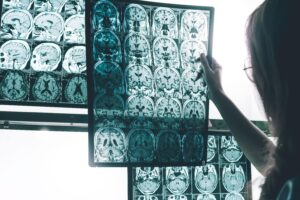Huntington’s disease is a rare hereditary brain disorder caused by a mutation in the huntingtin (HTT) gene. The mutation creates an abnormal protein that gradually damages neurons, causing problems with movement, mood, and cognition. Traditionally, experts have focused on saving or replacing the affected neurons before symptom onset, but a new study taps into the brain’s support cells, called glia, to halt the disease’s progression in adults already showing symptoms. Read on for more information on the study, published in Cell Reports in June, and the potential impact of glial replacement therapy.
Glial Replacement in R6/2 Mice Has Promising Results
As mentioned above, Huntington’s disease is caused by a mutation in the HTT gene. When the gene functions properly, it provides instructions for making a key protein, also called huntingtin. This protein is essential for physiological neuron development. When the gene malfunctions, abnormal huntingtin proteins are produced, resulting in neuron damage.
Huntington’s disease also negatively impacts glial cells, cells within the nervous system that regulate neuronal health. In a press release, Steve Goldman, lead author of the study and co-director of the University of Rochester Center for Translational Neuromedicine, called these cells the “essential caretakers of neurons.”
Focusing on this classification, Goldman’s team sought to replace diseased glia with healthy cells. The team wondered: Could glial replacement create a more supportive environment for neurons in adult mice, potentially preserving the nerve cells that are damaged and lost in Huntington’s disease? To find out, the research team worked with R6/2 mice. These mice are a commonly used model of Huntington’s disease, known for exhibiting motor and cognitive symptoms similar to those seen in humans with the disease.
Testing the Effects of Healthy Glia Transplanted into Symptomatic Mice
This research builds on previous work, which found that the neonatal engraftment of human glial progenitor cells (hGPCs) into mice yielded “substantial glial chimerization of the striatum.” This time, the team injected five-week-old R6/2 mice — considered young adult mice — with hGPCs, described in the press release as “early-stage glia that can mature into different types of glial cells.” At the time of injection, the mice had just begun to show symptoms of Huntington’s disease.
The hGPCs were injected directly into the mouse models’ striatum, a part of the brain essential for motor coordination, cognitive function, anxiety, and more. Following the injection, the research team observed the effect of healthy glia on diseased host neurons. The team took a multi-pronged approach to test their hypothesis, using a combination of observational work, RNA sequencing, and neuron labeling to observe the full impact of glial replacement therapy. The observational work involved testing the mice using tasks that measured coordination, movement, memory, and anxiety. Additionally, the team used single-nucleus RNA sequencing to see which genes may have been switched on or off after hGPC transplantation.
Positive Outcomes for Mice Treated with Glial Replacement
The treated R6/2 mice showed numerous positive outcomes, including a “clear delay in motor and cognitive deterioration.” The treated mice also lived several weeks longer than untreated HD mice. On the cellular level, the single-nucleus RNA sequencing strategy allowed the team to observe gene expression in the treated R6/2 mice. Where these mice would usually lose expression of genes involved in synapse function, many of these genes appeared to be “switched” back on in the treated mice.
_____
These findings show that the adult brain may still be repaired, even after the onset of symptoms associated with Huntington’s disease. “Even though treatment began after symptoms appeared, significant improvements were still seen — highlighting the potential for adult intervention,” said study co-author Abdellatif Benraiss. This focus on glial health could yield significant benefits, potentially broadening the therapeutic landscape for this rare, devastating disease.
To study Huntington’s disease, Scantox Neuro offers preclinical research in R6/2 mice as well as in zQ175 mice and BACHD rats. Each of these models features different pathological properties of the disease. Animals can be treated and evaluated with Huntington’s relevant behavioral tests. Furthermore, tissues can be analyzed for changes in HTT repeats, mRNA, and protein aggregates and related pathologies such as neuroinflammation. To model Huntington’s disease in vitro, L-glutamate-induced lesion of neuronal cells can be performed. All experiments can be adjusted to your special study requirements.
Scantox is the leading Nordic preclinical GLP-accredited contract research organization (CRO), delivering the highest grade of pharmacology and regulatory toxicology services since 1977. Scantox focuses on preclinical contract research services, supporting pharmaceutical and biotechnology companies with their drug development projects. Core competencies include explorative and efficacy studies, PK studies, general toxicology studies, local tolerance studies, wound healing studies, and vaccines. To learn more about our services and areas of study, please subscribe to our newsletter. And if you’re interested in partnering with us, please contact us online.











